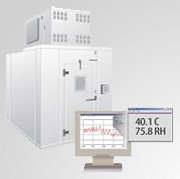- Home
- en
- datalogger-monitoring-systems
- vaisala-applications
- environmental-chambers
Vaisala - Temperature and Humidity Monitoring in a Climate Chamber
Stability testing and monitoring is a critical step in drug research, development and manufacturing. It impacts how pharmaceuticals are produced, packaged, labeled and sold.

The Challenge of Stability Testing
Stability testing and monitoring is a critical step in drug research, development and manufacturing. However, creating the exact environmental conditions in a stability test is a complex process, but necessary to comply with standards defined by regulatory bodies like ICH and the FDA as well as to ensure the safety and efficacy of pharmaceutical products.
If the data compiled during a stability study is inaccurate or incomplete, the credibility of the study is at risk and creates the potential for devastating liabilities and loss. Background knowledge of the basic attributes of sensors, their calibration details and the recording and reporting capabilities is helpful when deciding on a system for performing accurate, gap-free stability studies.
Sensors & Calibration: Crucial in Stability Testing
Temperature Sensors:
Temperature is an easier parameter to ensure because today's sensors are generally quite accurate and easy to calibrate.
Obtaining accurate humidity measurement is more complex; if your procedure requires that you cycle temperature and humidity, the humidity sensor has to be temperature-compensated for that range.
Humidity Sensors:
Unless the humidity sensor is of superb quality and properly calibrated, it will degrade to the point where data obtained is inaccurate, often useless. Most humidity sensors are highly unstable, losing accuracy from the exposure that is part of any rigorous stability testing process. This is why humidity sensors must be regularly calibrated, to reduce the "drift" in accuracy that occurs with each stability study. Calibration intervals will vary based on the type of sensor and the conditions of operation (range of temperature and humidity, atmospheric contaminants, and others).
Data Gaps:
A major issue in any validation process is the risk of "data gaps" in critical test procedures. Regardless of the system or method used (both chart recorders and centralized systems share this vulnerability), the potential for data gaps exists. Chart paper or ink can run out, or recorder mechanisms can be damaged, while centralized data recording systems can suffer from power or network failures, computer crashes and many others.
The Gap-free Solution:
All the issues of sensors, calibration and data reliability are addressed brilliantly by Vaisala.
Vaisala data loggers are highly accurate and stable, offering accuracy to +/-1%RH and +/-0.10°C, making them the most accurate battery powered loggers in the world.
Vaisala sets the standard concerning sensor long term stability, with a guaranteed accuracy of 0.15°C and 2%RH at the end of the first year of operation (!)
The humidity sensors employed by Vaisala do not just use a single set-point, but are calibrated across a broad temperature and humidity range. Vaisala data loggers are small, completely self-contained with a 10-year battery and can be placed unobtrusively in chambers without any wires to perform validation and mapping tasks.
Fully validatable, Vaisala loggers produce secure and unalterable data that are fully FDA 21 CFR Part 11 compliant.
Should you wish to create a continuous, fully automated monitoring solution with alarming via PC, e-mail or cell phone, simply connect the loggers to your existing IT infrastructure and monitor centrally through the "viewLinc" software.
Vaisala - A reliable, accurat and gap-free system giving you peace of mind.

